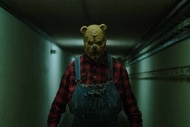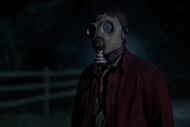Create a free profile to get unlimited access to exclusive videos, sweepstakes, and more!
Internalized queerphobia and the power of self-acceptance in Doom Patrol

“Larry Trainor was an American God. Air Force aviator. Test pilot. Short-listed for the Mercury Space program. An Atomic Age sex machine,” says Mr. Nobody, the narrator (and villain) of Doom Patrol’s Season 1. As Mr. Nobody provides an unrivaled introduction to one of our merry band of heroes, Larry struts confidently toward a large plane.
The year is 1961 and Larry is about to test an experimental rocket plane that will pave the way for space travel. Except, when Larry reaches the mesosphere, he is confronted by a wave of energy that debilitates him and causes his rocket to freefall from space. Larry’s wife and children watch as his plane crashes to the ground in the distance—and the man we will come to know is Larry’s lover rushes to the crash site.
Larry emerges from the fiery wreckage, burned head to toe, but walking, talking, miraculously alive. And, it turns out, he’s no longer alone. Inside him resides the Negative Spirit, a being made of an energy type unknown to humanity.
Over the decades they are stuck together, Larry first hates and resents the Negative Spirit, furious at him for neither being able to leave Larry nor communicating with him — but what Larry finds is that it isn’t the Negative Spirit that is hurting him. Instead, it's the internalized queerphobia that also resides within.
The TV adaptation of Doom Patrol is about a bunch of losers who wouldn’t even call themselves superheroes. In addition to Larry, the superpowered misfits taken in by Dr. Niles Caulder include: Cliff Steele, a race car driver who is now a brain in a robotic body; Jane, a person with 64 personalities (each with their own super-power); Rita Farr, a Hollywood star turned hyper-malleable stress-case; and Victor Stone, better known as Cyborg. (Yes, Cyborg of the Justice League. Yes, it comes up a lot.)
Together, this team of nobodies faces Mr. Nobody, a seemingly all-powerful baddie and former member of the Brotherhood of Evil. (He got kicked out for being basic.) And, Mr. Nobody knows just how to manipulate the team into doing exactly what he wants.
Despite purportedly being a superhero adaptation, Doom Patrol spends the bulk of the 15 episodes of Season 1 exploring the trauma and recovery (and relapse) of each of the main characters. Sometimes the series gets heavy—as when Jane confronts memories of her abusive childhood—but by and large, that heaviness is balanced with sardonic humor and unflinching insight into the despicability and honorability of humanity and human impulse.
For Larry, much of his development has to do with his identity as a queer person and how he has internalized the queerphobia leveraged against him by our society. Internalized queerphobia describes the phenomenon whereby queer people believe negative things about themselves due to their sexuality. These negative beliefs can lead to depression and anxiety, anger and frustration at the “wrong” kind of queer people, and other self-destructive behaviors.
Doom Patrol excels in using the existing relationship between Larry and the Negative Spirit, which is present in the comics, to explicitly explore how Larry feels about himself and his queerness, unabashedly revealing the negative effects of internalized queerphobia on both individuals and their relationships with others.
While there are several turning points that help Larry learn to accept and embrace both the Negative Spirit and his queerness — Jane’s insight about respecting her personalities, as well as the moving reconciliation between Larry and his ex-lover — the most compelling and stark example takes place when Larry meets Danny the Street.
Before their meeting, Larry has an ambivalent and often antagonistic relationship with the Negative Spirit, who renders Larry unconscious whenever they leave his body. In the series, other characters call the Negative Spirit “it” and “he,” but it’s unclear what pronouns they would choose, so I’m using the humanizing, yet gender-inclusive “them.” Larry has tried ignoring and controlling the Negative Spirit and neither works.
While visiting Danny, a genderqueer and mystical living street, Larry and Victor learn that Danny is being chased by the Bureau of Normalcy, a covert government organization dedicated to the capture, weaponization, or elimination of those deemed deviant and abnormal. This revelation terrifies Larry and the Negative Spirit who know the Bureau all too well, having been tortured by them after the crash. Larry decides to leave Danny and his Dannyzens, the people who come to live on and with Danny, but finds himself sitting in Danny’s central building, Peeping Tom’s Perpetual Cabaret.
Larry is asked to sing, climbs to the stage, and belts out Kelly Clarkson’s “People Like Us.” The audience and stage erupt into a dance party of free queer people singing about their freedom. It is a fabulous moment, one where we see Larry breaking out of his internalized homophobia and embracing himself.
But, it’s not real. This is an imagined moment, a wished-for reality that Larry doesn’t quite have the courage to seize. Larry doesn’t take to the stage and connect with his queer family to free himself. He runs away, avoiding the pain and the joy that comes with facing himself. The moment the music drops and we see Larry push away the mic, saying “I don’t sing,” it makes stark the life Larry could have versus the one he does.
It is only after the Dannyzens confront and defeat the Bureau agents who infiltrate Danny that Larry sings karaoke, (unfortunately offscreen) shedding some of his fear — not just of the Bureau, but of himself, his queerness, and the Negative Spirit.
At the beginning of the season, it seems like the series posits the Negative Spirit as a cipher for dangerous queer libido — such as when Larry’s wife breaks up with him after the accident due to his “late-night beers” with the boys. However, as he learns to accept his own sexuality, things begin to shift between Larry and the Negative Spirit. They begin to cooperate and scheme, no longer stuck together but chosen partners. With this turn of events, the Negative Spirit becomes not a metaphor for nefarious queer appetites, but rather a recognition of the reality of internalized queerphobia and how it convinces us to poison ourselves. Larry heals his relationship with the Negative Spirit by healing his relationship with himself.
The Larry we see risking his life to save everyone, working with the Negative Spirit, and believing in himself in the finale is not the Larry we meet in the pilot, and all of his work to accept and love himself — while combatting his internalized hatred — ultimately empowers him to love and care for his Doom Patrol family.
The views and opinions expressed in this article are the author's, and do not necessarily reflect those of SYFY WIRE, SYFY, or NBC Universal.





























